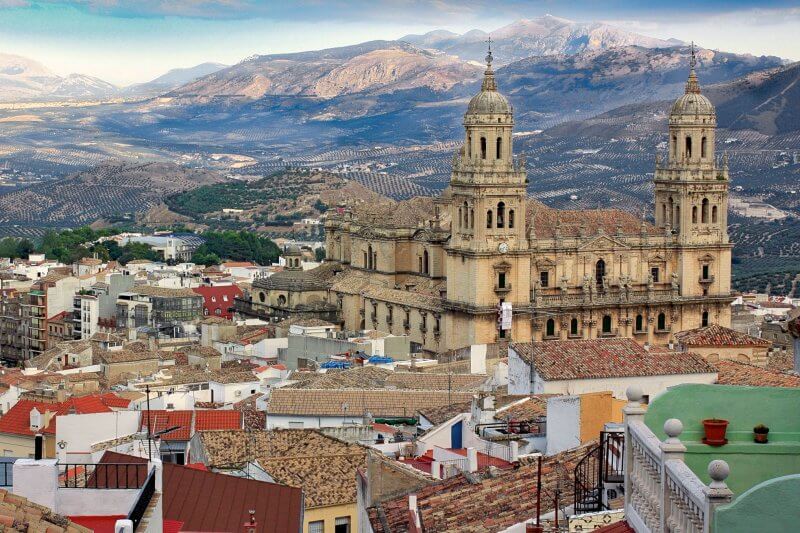The city of Jaén is located in a typical Spanish province near the mountain of Santa Catalina. Andalusia is distinguished by its picturesque nature, people have chosen these lands many centuries ago, for a long time the Romans, Arabs, claimed Christians. Today Jaén in Spain is a combination of different cultures, a huge number of historical and architectural monuments and, of course, endless olive plantations that stretch to the horizon.
General information
If you’re planning a trip to Andalusia, be sure to visit this off-the-beaten-path town in Spain, and there are several reasons for doing so. Firstly, it’s home to numerous historical monuments, many of which date back to the Moorish era. Secondly, Jaén is known as the “Olive Oil Capital” of Spain, as it produces 20% of the world’s olive oil. As you enter the city, you’ll be greeted by endless rows of green trees.
An interesting fact! There are about 15 trees per inhabitant in Jaén, Andalusia.
Jaén is the capital of the province of the same name, located in the south of the country. Compared to other settlements in the province, Jaén is a fairly large city, with a population of almost 117,000 people and an area of 424.3 km2. The city is known as the “Pearl of Andalusia,” and for good reason, as many of its monuments and architectural structures have been recognized by UNESCO as World Heritage sites. In addition to being the administrative center of the province, Jaén is also an economic hub.
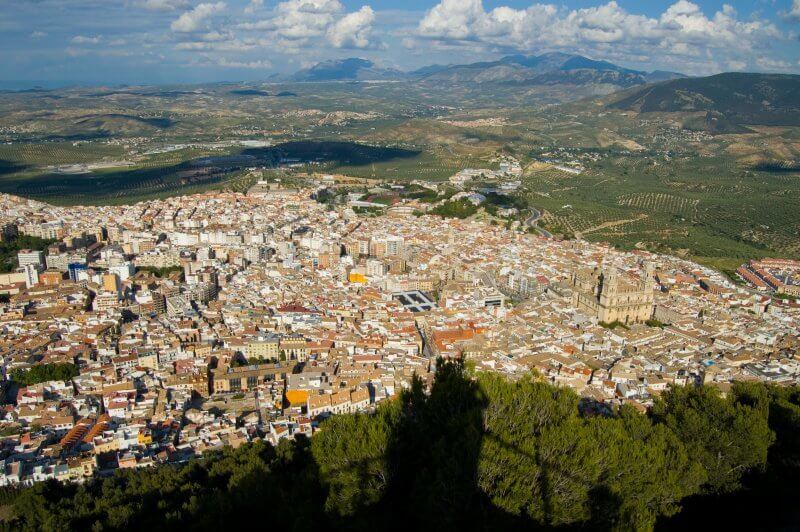
Historical excursion
The fact that Jaén in Spain has a high concentration of attractions indicates that the city’s history is rich in various events. People have been living here for over five millennia, leaving behind cave paintings that have been declared a part of the World Heritage.
In the 5th century BC, the Iberians settled in Jaén, followed by the Carthaginians, and in the 2nd century BC, the Romans took control of the city. With the arrival of the Arabs, Jaén flourished and became the capital of the Muslim Empire, but 500 years later, the Christians regained control.
An interesting fact! Unfortunately, there are no prehistoric monuments left in the city of Andalusia, but the Arab past is preserved here at every turn.
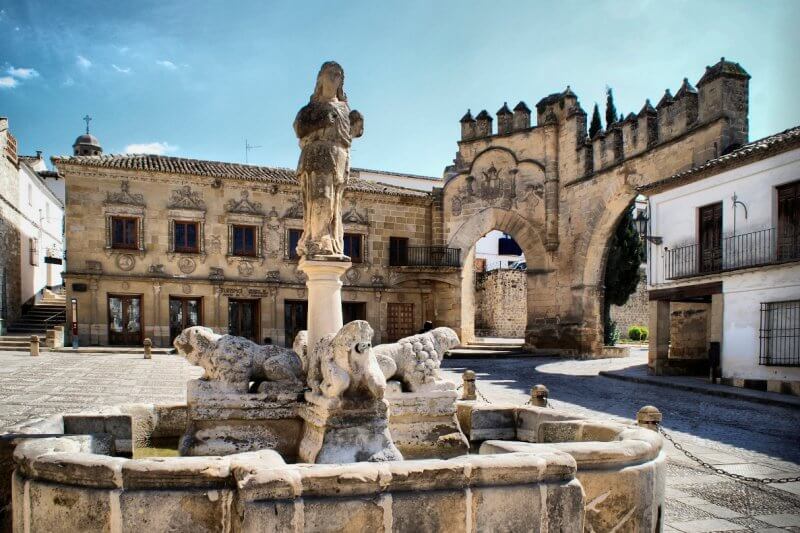
The geographical location of Jaén in Spain has always been considered strategically important, which is why it is also known as the Holy Kingdom. Even after Jaén was conquered by the Christians, the city was periodically raided by Muslims.
In the 19th century, the French settled in the city, and this period of history was difficult. To commemorate these challenging times, a prisoner in chains is kept in the prison of the Santa Catalina Palace.
The next difficult period in the history of Jaén was the Civil War, which lasted from 1936 to 1939. During this time, people were arrested en masse in the city, and the prisons were overcrowded.
Attractions
The city in Spain is beautiful in a special, mysterious beauty, make sure of this, walking its streets, relaxing in cafes, admiring the natural beauty. We have made a selection of the most interesting sights of Jaén.
The Cathedral
The Cathedral of Jaén is considered to be the best Renaissance building in Spain. It was built over a period of two centuries, and it is not surprising that it has a mix of different styles.
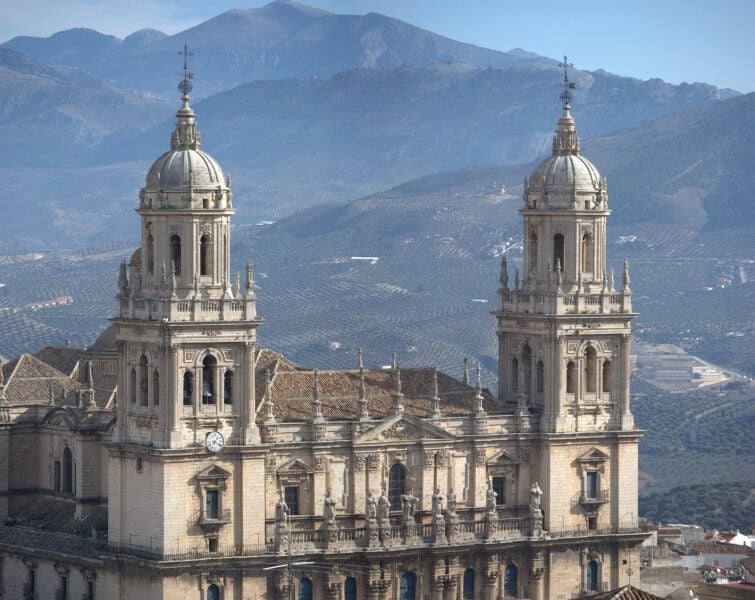
In the 13th century, Jaén was conquered from the Moors, and the mosque was consecrated in honor of the Ascension of the Virgin, and Christian services were held there until the mid-14th century. Then the church burned down, and a new church was built in the Gothic style, but the architects made a mistake, and the building was declared unsafe for use.
The new church was not built until the end of the 15th century. According to the original plan, the church was to have five naves, but the building was not stable enough, so it was rebuilt in the Renaissance style. The construction took 230 years to complete. The church was consecrated in the mid-17th century, but the western facade was not yet finished. The architect Eufrazio de Rojas, who was in charge of the construction at the time, chose a luxurious Baroque style for the facade. The twin towers located at the edges of the temple were completed by the mid-18th century.
The church building is built in the shape of a cross, with a rectangular nave at its base, complemented by chapels. The façade is recognized as a typical example of Spanish Baroque architecture, adorned with statues, sculptures, and columns. The main façade features three portals: the Portal of Forgiveness, the Portal of the Faithful, and the Portal for Priests.
Inside, the church is also decorated in different styles, with naves separated by columns that reach up to the ceiling, and a vault decorated with half-arches. The altar is designed in the neoclassical style, while the sculpture of the Virgin Mary is in the Gothic style. In the center of the cathedral, there is a choir with wooden benches adorned with carvings, and beneath the choir is a tomb.

The cathedral also houses a museum that contains art objects, some of which are unique.
Important! During services, admission to the cathedral is free; otherwise, a ticket is required to fully explore the cathedral and visit the museum.
Arab baths
The attraction was built in the early 11th century and is the largest Moorish bathhouse complex in Andalusia. Located under the Villardompardo Palace, the baths and the Museum of Folk Arts form a cultural and tourist center of the city.
An interesting fact! According to one of the legends, the monarch of Tayfa, Ali, was killed in the Arab baths.
In the Islamic religion, washing the body was considered an act of purification of the soul and thoughts. Since not everyone could afford a bathtub in their homes, Haena was home to bathhouses where both men and women could wash themselves. The baths of Haena cover an area of 470 square meters, and archaeological evidence suggests that they were restored in the late 12th century and later converted into workshops.

It is noteworthy that the Arab baths were discovered only in the early 20th century, as the palace is located above them, and they are in excellent condition. The complex was restored until 1984.
Today, tourists can visit the attraction and see:
- lobby area;
- a cold room;
- a warm room;
- a hot room.
Practical information:
- address of the attraction: Plaza Santa Luisa de Marillac, 9 Jaén;
- working hours: every day from 11:00 to 19:00;
- The ticket price is 2.5 euros (free admission for EU citizens).
Santa Catalina Castle
Santa Catalina Castle is called the Castle on the Mountain by the locals, as it is built on a hill and looks like a set for a historical saga. The fortress is Moorish, but it was given a Christian name in the mid-13th century, when the city came under the rule of Ferdinand III of Castile.
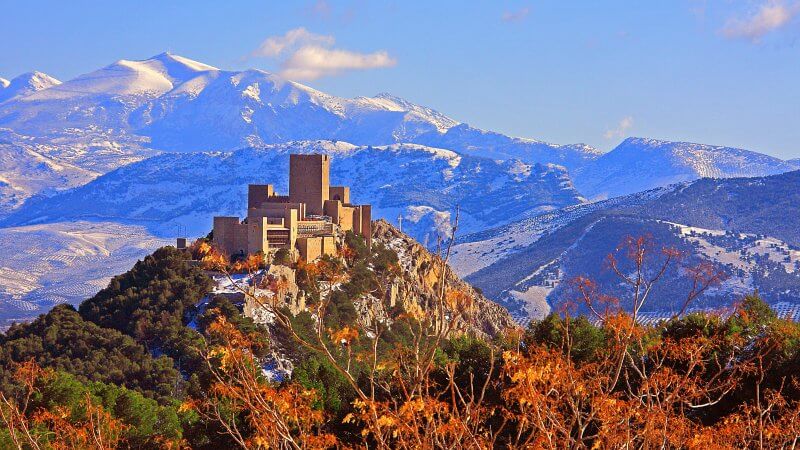
From a height of 820 m, you can see the Sierra Nevada mountains, picturesque olive groves, and small villages. People have lived on this hill since before the Common Era, as evidenced by Bronze Age artifacts. The first fortifications were built here by the Carthaginians, and later, under King Alhamar, the fortress was expanded and fortified, and a Gothic chapel was added. When Napoleon’s troops settled in the city, the castle was converted for military purposes. Then, for several decades, no one remembered the castle, and only in 1931 was the landmark of Jaén in Spain declared a historical monument.
An interesting fact! Today, you can not only walk around the castle, but also stay at a hotel.
Practical information:
- Attraction opening hours: winter and spring: 10:00-18:00 (Monday-Saturday), 10:00-15:00 (Sunday); summer: 10:00-14:00, 17:00-21:00 (Monday-Saturday), 10:00-15:00 (Sunday);
- the ticket price is 3.50 euros;
- every Wednesday, admission to the attraction is free;
- Tours are held from 12:00 to 16:30 (Monday-Saturday), at 12:00 (Sunday), and are included in the ticket price.
La Cruz Observation Deck
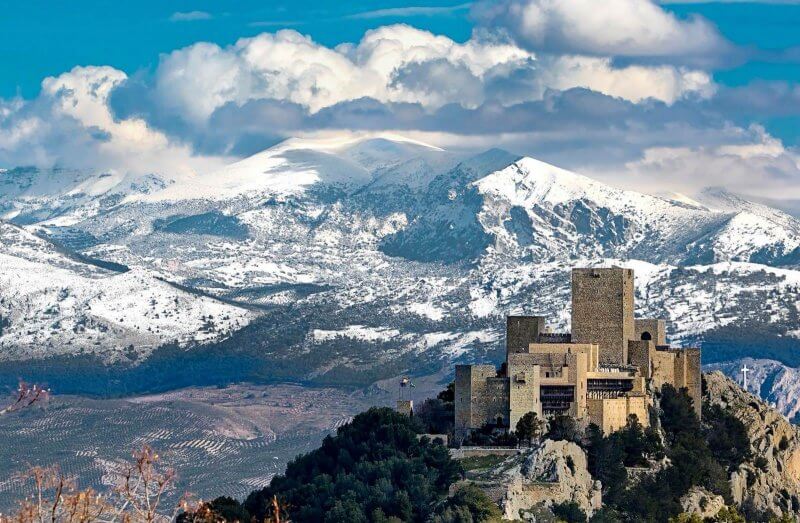
The observation deck is located near the Santa Catalina Castle, and there is a commemorative cross in honor of the Christian conquest of Jaén in the 13th century. Previously, a wooden cross was erected on this site, but it was replaced with a more modern white cross.
You can drive to the top by car or take a taxi, as the viewing is open 24 hours a day and is free. You can visit the viewpoint at any time. It is recommended to visit the viewpoint in the evening, when it gets dark and the city lights up.
Jaen Museum
This is the main city museum, which features a permanent exhibition of archaeological finds and art objects. The exhibition tells the story of the development of art and culture in Jaén.
Previously, the museum was called the Provincial Museum, and it is located near the Cathedral, specifically on Avenue de la Estacion. After the merger of the Archaeological Museum and the Museum of Fine Arts, a new attraction was opened in a large building.
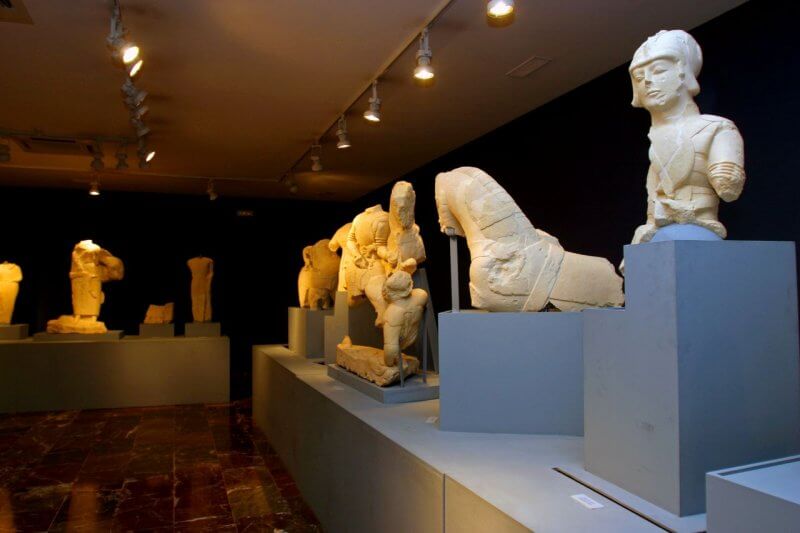
The archaeological exhibition features finds from several different periods. These include burial decorations, ceramics, ancient Roman sculptures, Roman mosaics, and religious objects. There are also numerous statues, ancient columns, a sarcophagus, and stone tombs.
The art collection is on the second floor and includes ancient paintings (13th-18th century) and modern works of art (19th-20th century).
Practical information:
- Attraction opening hours: from January to June 15, from September 16 to the end of December, from 09:00 to 20:00 (Tuesday to Saturday), from 09:00 to 15:00 (Sunday), from June 16 to September 15, from 09:00 to 15:00;
- The ticket price is 1.5 euros, and admission is free for European Union residents.
Jaén is the Olive Paradise of Andalusia
The city has a monument to olive oil and this is not surprising, because Jaen is recognized as a world leader in the production of oil and olives. By the way, olives are sold almost everywhere in the city, and there are many olive groves around Jaen – it’s hard to imagine the urban landscape without the trees that have become an integral part of the Spanish settlement. There is also an Olive Tree Museum in the city. That’s why another name for Jaen is the olive paradise of Andalusia.
An interesting fact! The province of Jaén is home to 66 million olive trees and produces 20% of the world’s olive oil.
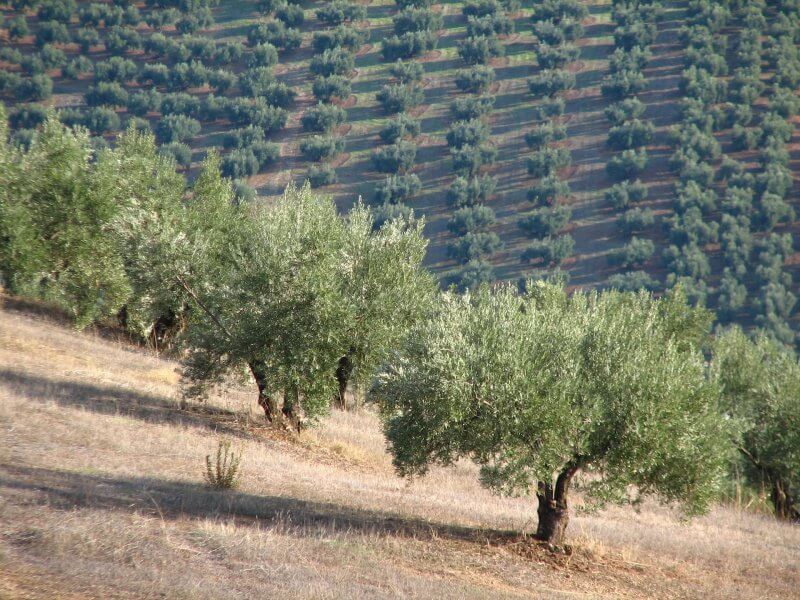
The La Laguna estate offers interesting excursions for tourists, including a visit to the poetic and solemn Cathedral of Oil, where guests can learn about the technology of olive tree cultivation and the stages of olive oil production. Tourists can also try three different types of olive oil.
Another popular olive valley, visited by many tourists, is located near the Guadalquivir River, surrounded by the Sierra de Cazorla and Sierra Mágina mountains.
The province of Jaén is the world’s leading producer of olive oil. According to statistics, it produces more olive oil than the entire country of Italy. The locals are very proud of their product, so be sure to bring back a bottle of this aromatic treat.
It’s good to know! The most popular olive varieties are Picul, Arbekin, and Royal. Royal is the variety used to make sweet olive oil with a pleasant fruity flavor. Royal is a unique local variety that cannot be found in other countries.

There are many different producers in the region of Jaén in Andalusia, many of which have a long and rich history. Pay attention to the Castillo de Cánena brand of olive oil. The harvest in Jaén begins in October and continues until February. Green olives are harvested first, followed by black olives at the end of the season. One tree can produce up to 35 kilograms of olives. It is noteworthy that self-respecting oil producers do not produce oil from olives that have fallen to the ground, but leave them there to maintain the quality and purity of the oil. The harvest is processed within 6 hours of collection.
If your vacation in Spain is planned for October, be sure to visit the Luka Fair, where there is a lot of oil, wine, and ceramics. Olive products, such as pasta and candles, are in high demand.
Public transport links
Jaén is a major transportation hub between Madrid and Malaga, and can be reached by various means of transportation, including trains, buses, and cars.
It’s useful to know! The easiest way to travel around Spain is by renting a vehicle. There are many rental agencies in all Spanish cities, and the requirements for customers are minimal.
From Malaga to Jaén, you can take the A-92 and A-44 highways, which pass through Granada, a city with an Arab heritage. The journey takes about two hours.
There are no direct public transport train services from Malaga, and you will need to transfer in Cordoba. The journey takes 3-4 hours. Please check the exact schedule on the Raileurope website.

You can take a bus from Malaga to Jaén, which takes 3 hours, and there are 4 scheduled departures (Alsa bus company — www.alsa.com). It is better to buy tickets in advance or at the bus station.
From Madrid to Jaén, you can take the A-4 motorway, which takes about 3.5 hours by car. There is also a direct train connection. The train ride takes about 4 hours. You can also take a train with a connection in Córdoba. There is also a direct bus service, with 4 departures per day and a journey time of approximately 5 hours. It is recommended to book your tickets in advance or purchase them at the train station.
The city of Jaén is part of the province of Andalusia, and it is where the Guadalquivir River begins. The landscape of this part of Spain is picturesque, with green plains, mountains, and natural parks. Jaén is known for its natural beauty, allowing visitors to escape the hustle and bustle of the city and explore its many ancient landmarks.

